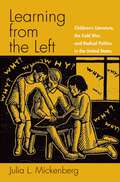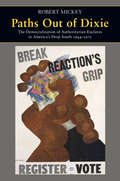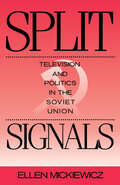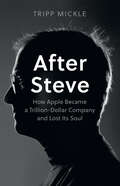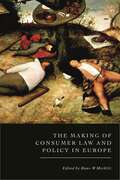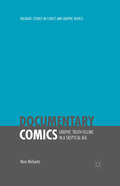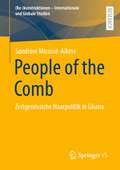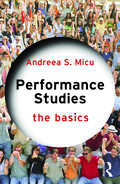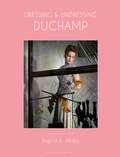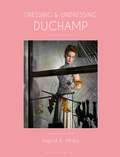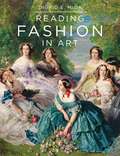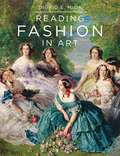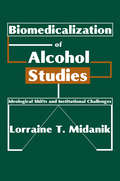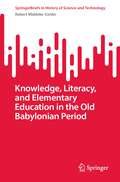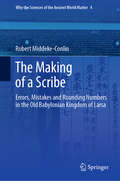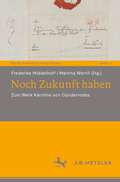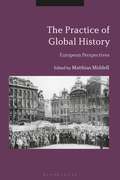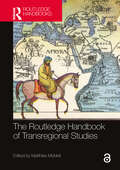- Table View
- List View
Learning from the Left: Children's Literature, the Cold War, and Radical Politics in the United States
by Julia L. MickenbergAt the height of the Cold War, dozens of radical and progressive writers, illustrators, editors, librarians, booksellers, and teachers cooperated to create and disseminate children's books that challenged the status quo. Learning from the Left provides the first historic overview of their work. Spanning from the 1920s, when both children's book publishing and American Communism were becoming significant on the American scene, to the late 1960s, when youth who had been raised on many of the books in this study unequivocally rejected the values of the Cold War, Learning from the Left shows how "radical" values and ideas that have now become mainstream (including cooperation, interracial friendship, critical thinking, the dignity of labor, feminism, and the history of marginalized people), were communicated to children in repressive times. A range of popular and critically acclaimed children's books, many by former teachers and others who had been blacklisted because of their political beliefs, made commonplace the ideas that McCarthyism tended to call "subversive." These books, about history, science, and contemporary social conditions-as well as imaginative works, science fiction, and popular girls' mystery series-were readily available to children: most could be found in public and school libraries, and some could even be purchased in classrooms through book clubs that catered to educational audiences. Drawing upon extensive interviews, archival research, and hundreds of children's books published from the 1920s through the 1970s, Learning from the Left offers a history of the children's book in light of the history of the history of the Left, and a new perspective on the links between the Old Left of the 1930s and the New Left of the 1960s. Winner of the Grace Abbott Book Prize of the Society for the History of Children and Youth
Paths Out of Dixie: The Democratization of Authoritarian Enclaves in America's Deep South, 1944-1972
by Robert MickeyThe transformation of the American South--from authoritarian to democratic rule--is the most important political development since World War II. It has re-sorted voters into parties, remapped presidential elections, and helped polarize Congress. Most important, it is the final step in America's democratization. Paths Out of Dixie illuminates this sea change by analyzing the democratization experiences of Georgia, Mississippi, and South Carolina. Robert Mickey argues that Southern states, from the 1890s until the early 1970s, constituted pockets of authoritarian rule trapped within and sustained by a federal democracy. These enclaves--devoted to cheap agricultural labor and white supremacy--were established by conservative Democrats to protect their careers and clients. From the abolition of the whites-only Democratic primary in 1944 until the national party reforms of the early 1970s, enclaves were battered and destroyed by a series of democratization pressures from inside and outside their borders. Drawing on archival research, Mickey traces how Deep South rulers--dissimilar in their internal conflict and political institutions--varied in their responses to these challenges. Ultimately, enclaves differed in their degree of violence, incorporation of African Americans, and reconciliation of Democrats with the national party. These diverse paths generated political and economic legacies that continue to reverberate today. Focusing on enclave rulers, their governance challenges, and the monumental achievements of their adversaries, Paths Out of Dixie shows how the struggles of the recent past have reshaped the South and, in so doing, America's political development.
Paths Out of Dixie: The Democratization of Authoritarian Enclaves in America's Deep South, 1944-1972
by Robert MickeyThe transformation of the American South--from authoritarian to democratic rule--is the most important political development since World War II. It has re-sorted voters into parties, remapped presidential elections, and helped polarize Congress. Most important, it is the final step in America's democratization. Paths Out of Dixie illuminates this sea change by analyzing the democratization experiences of Georgia, Mississippi, and South Carolina. Robert Mickey argues that Southern states, from the 1890s until the early 1970s, constituted pockets of authoritarian rule trapped within and sustained by a federal democracy. These enclaves--devoted to cheap agricultural labor and white supremacy--were established by conservative Democrats to protect their careers and clients. From the abolition of the whites-only Democratic primary in 1944 until the national party reforms of the early 1970s, enclaves were battered and destroyed by a series of democratization pressures from inside and outside their borders. Drawing on archival research, Mickey traces how Deep South rulers--dissimilar in their internal conflict and political institutions--varied in their responses to these challenges. Ultimately, enclaves differed in their degree of violence, incorporation of African Americans, and reconciliation of Democrats with the national party. These diverse paths generated political and economic legacies that continue to reverberate today. Focusing on enclave rulers, their governance challenges, and the monumental achievements of their adversaries, Paths Out of Dixie shows how the struggles of the recent past have reshaped the South and, in so doing, America's political development.
Split Signals: Television and Politics in the Soviet Union (Communication and Society)
by Ellen MickiewiczTelevision has changed drastically in the Soviet Union over the last three decades. In 1960, only five percent of the population had access to TV, but now the viewing population has reached near total saturation. Today's main source of information in the USSR, television has become Mikhail Gorbachev's most powerful instrument for paving the way for major reform. Containing a wealth of interviews with major Soviet and American media figures and fascinating descriptions of Soviet TV shows, Ellen Mickiewicz's wide-ranging, vividly written volume compares over one hundred hours of Soviet and American television, covering programs broadcast during both the Chernenko and Gorbachev governments. Mickiewicz describes the enormous significance and popularity of news programs and discusses how Soviet journalists work in the United States. Offering a fascinating depiction of the world seen on Soviet TV, she also explores the changes in programming that have occurred as a result of glasnost.
After Steve: How Apple Became A Trillion-dollar Company And Lost Its Soul
by Tripp MickleFrom the Wall Street Journal’s Tripp Mickle, the dramatic, untold story inside Apple after the passing of Steve Jobs by following his top lieutenants—Jony Ive, the Chief Design Officer, and Tim Cook, the COO-turned-CEO—and how the fading of the former and the rise of the latter led to Apple losing its soul.
The Making of Consumer Law and Policy in Europe
by Hans W MicklitzThis book analyses the founding years of consumer law and consumer policy in Europe. It combines two dimensions: the making of national consumer law and the making of European consumer law, and how both are intertwined. The chapters on Germany, Italy, the Nordic countries and the United Kingdom serve to explain the economic and the political background which led to different legal and policy approaches in the then old Member States from the 1960s onwards. The chapter on Poland adds a different layer, the one of a former socialist country with its own consumer law and how joining the EU affected consumer law at the national level. The making of European consumer law started in the 1970s rather cautiously, but gradually the European Commission took an ever stronger position in promoting not only European consumer law but also in supporting the building of the European Consumer Organisation (BEUC), the umbrella organisation of the national consumer bodies. The book unites the early protagonists who were involved in the making of consumer law in Europe: Guido Alpa, Ludwig Krämer, Ewa Letowska, Hans-W Micklitz, Klaus Tonner, Iain Ramsay, and Thomas Wilhelmsson, supported by the younger generation Aneta Wiewiórowska Domagalska, Mateusz Grochowski, and Koen Docter, who reconstructs the history of BEUC. Niklas Olsen and Thomas Roethe analyse the construction of this policy field from a historical and sociological perspective.This book offers a unique opportunity to understand a legal and political field, that of consumer law and policy, which plays a fundamental role in our contemporary societies.
The Making of Consumer Law and Policy in Europe
by Hans-W MicklitzThis book analyses the founding years of consumer law and consumer policy in Europe. It combines two dimensions: the making of national consumer law and the making of European consumer law, and how both are intertwined. The chapters on Germany, Italy, the Nordic countries and the United Kingdom serve to explain the economic and the political background which led to different legal and policy approaches in the then old Member States from the 1960s onwards. The chapter on Poland adds a different layer, the one of a former socialist country with its own consumer law and how joining the EU affected consumer law at the national level. The making of European consumer law started in the 1970s rather cautiously, but gradually the European Commission took an ever stronger position in promoting not only European consumer law but also in supporting the building of the European Consumer Organisation (BEUC), the umbrella organisation of the national consumer bodies. The book unites the early protagonists who were involved in the making of consumer law in Europe: Guido Alpa, Ludwig Krämer, Ewa Letowska, Hans-W Micklitz, Klaus Tonner, Iain Ramsay, and Thomas Wilhelmsson, supported by the younger generation Aneta Wiewiórowska Domagalska, Mateusz Grochowski, and Koen Docter, who reconstructs the history of BEUC. Niklas Olsen and Thomas Roethe analyse the construction of this policy field from a historical and sociological perspective.This book offers a unique opportunity to understand a legal and political field, that of consumer law and policy, which plays a fundamental role in our contemporary societies.
Documentary Comics: Graphic Truth-Telling in a Skeptical Age (Palgrave Studies in Comics and Graphic Novels)
by Nina MickwitzCan comics be documentary, and can documentary take the form of, and thus be, comics? Examining comics as documentary, this book challenges the persistent assumption that ties documentary to recording technologies, and instead engages an understanding of the category in terms of narrative, performativity and witnessing. Through a cluster of early twenty-first century comics, Nina Mickwitz argues that these comics share a documentary ambition to visually narrate and represent aspects and events of the real world.
People of the Comb: Zeitgenössiche Haarpolitik in Ghana ((Re-)konstruktionen - Internationale und Globale Studien)
by Sandrine Micossé-Aikins"Afrika" dient in vielen haarpolitischen Debatten nur als positive und teilweise sehr unpräzise definierte Projektionsfläche, die für eine bessere vorkoloniale Schwarze Welt steht. Nur wenig Aufmerksamkeit wurde bisher darauf verwendet, die tatsächlich gegenwärtig gelebte Haarkultur- und -politik in verschiedenen kontinentalafrikanischen Kontexten auch auf ihr Eingebettet-Sein in globale, historisch gewachsene Hierarchien hin zu betrachten. Oft wird übersehen, dass auch hier – auf ihre eigene Weise – rassistische Ideologien und insbesondere weiße Vorherrschaft als koloniale Kontinuitäten wirken, und zeitgenössische Haarkultur mitprägen. Die vorliegende Arbeit möchte einen Beitrag dazu leisten, diese Dynamiken besser zu verstehen. Dabei werden jedoch auch relevante Facetten Schwarzen Selbstverständnisses und gelebte ästhetische Praktiken beleuchtet, die über die Auseinandersetzung mit weißer Vorherrschaft hinausweisen.
Performance Studies: The Basics (The Basics)
by Andreea S. MicuPerformance Studies: The Basics offers an overview of the multiple, often overlapping definitions of performance, from performance art, performance as everyday life, and rituals, to the performative dimensions of identity, such as gender, race and sexuality. This book defines the interdisciplinary field of performance studies as it has evolved over the past four decades at the intersection of academic scholarship and artistic and activist practices. It discusses performance as an important means of communicating and of understanding the world, highlighting its intersections with critical theory and arguing for the importance of performance in the study of human behaviour and social practices. Complete with a helpful glossary and bibliography, as well as suggestions for further reading, this book is an ideal starting point for those studying performance studies as well as for general readers with an interest in the subject.
Performance Studies: The Basics (The Basics)
by Andreea S. MicuPerformance Studies: The Basics offers an overview of the multiple, often overlapping definitions of performance, from performance art, performance as everyday life, and rituals, to the performative dimensions of identity, such as gender, race and sexuality. This book defines the interdisciplinary field of performance studies as it has evolved over the past four decades at the intersection of academic scholarship and artistic and activist practices. It discusses performance as an important means of communicating and of understanding the world, highlighting its intersections with critical theory and arguing for the importance of performance in the study of human behaviour and social practices. Complete with a helpful glossary and bibliography, as well as suggestions for further reading, this book is an ideal starting point for those studying performance studies as well as for general readers with an interest in the subject.
Dressing and Undressing Duchamp
by Ingrid E. MidaFashion is a subject that has long been marginalized in art history and in museums. And yet, one of the most well-known artists in the twentieth century - Marcel Duchamp - created works that challenge the notion that fashion does not belong in the museum. As well, there is material evidence of his engagement with clothing as part of his oeuvre. This book reveals that clothing and dressing are significant themes that recur in Duchamp's life and his work – including his drawings, his fashioning of his body, his readymades, and in his curatorial gestures. In examining the items of clothing worn by Duchamp and the related traces of his wardrobe management, Duchamp is unmasked as a dandy. His waistcoat readymade series 'Made to Measure' (1957-1961) is in fact a remarkable and deliberate effort to recalibrate the definition of the readymade to include clothing. With this little-studied readymade series, Duchamp established a precedent for sartorial art as a valid form of artistic expression. In considering the material traces of Duchamp's fashioning of his body and identity in his work and life, this book makes a highly original contribution to the understanding of Duchamp's work as well as the significance of the clothed body in the vanguard of Modernism. Ultimately, this book explains the relevance of fashion in the museum to modern audiences today.
Dressing and Undressing Duchamp
by Ingrid E. MidaFashion is a subject that has long been marginalized in art history and in museums. And yet, one of the most well-known artists in the twentieth century - Marcel Duchamp - created works that challenge the notion that fashion does not belong in the museum. As well, there is material evidence of his engagement with clothing as part of his oeuvre. This book reveals that clothing and dressing are significant themes that recur in Duchamp's life and his work – including his drawings, his fashioning of his body, his readymades, and in his curatorial gestures. In examining the items of clothing worn by Duchamp and the related traces of his wardrobe management, Duchamp is unmasked as a dandy. His waistcoat readymade series 'Made to Measure' (1957-1961) is in fact a remarkable and deliberate effort to recalibrate the definition of the readymade to include clothing. With this little-studied readymade series, Duchamp established a precedent for sartorial art as a valid form of artistic expression. In considering the material traces of Duchamp's fashioning of his body and identity in his work and life, this book makes a highly original contribution to the understanding of Duchamp's work as well as the significance of the clothed body in the vanguard of Modernism. Ultimately, this book explains the relevance of fashion in the museum to modern audiences today.
Reading Fashion in Art
by Ingrid E. MidaDress and fashion are central to our understanding of art. From the stylization of the body to subtle textile embellishments and richly symbolic colors, dress tells a story and provides clues as to the cultural beliefs of the time in which artworks were produced. This concise and accessible book provides a step-by-step guide to analysing dress in art, including paintings, photographs, drawings and art installations. The first section of the book includes an introduction to visual analysis and explains how to 'read' fashion and dress in an artwork using the checklists. The second section offers case studies which demonstrate how artworks can be analysed from the point of view of key themes including status and identity, modernity, ideals of beauty, gender, race, globalization and politics. The book includes iconic as well as lesser known works of art, including work by Elisabeth Vigée le Brun, Thomas Gainsborough, James Jacques Tissot, Marcel Duchamp and Man Ray, Yinka Shonibare, Mickalene Thomas, Kent Monkman and many others. Reading Fashion in Art is the perfect text for students of fashion coming to art history for the first time as well as art history students studying dress in art and will be an essential handbook for any gallery visitor. The step-by-step methodology helps the reader learn to look at any work of art that includes the dressed or undressed body and confidently develop a critical analysis of what they see.
Reading Fashion in Art
by Ingrid E. MidaDress and fashion are central to our understanding of art. From the stylization of the body to subtle textile embellishments and richly symbolic colors, dress tells a story and provides clues as to the cultural beliefs of the time in which artworks were produced. This concise and accessible book provides a step-by-step guide to analysing dress in art, including paintings, photographs, drawings and art installations. The first section of the book includes an introduction to visual analysis and explains how to 'read' fashion and dress in an artwork using the checklists. The second section offers case studies which demonstrate how artworks can be analysed from the point of view of key themes including status and identity, modernity, ideals of beauty, gender, race, globalization and politics. The book includes iconic as well as lesser known works of art, including work by Elisabeth Vigée le Brun, Thomas Gainsborough, James Jacques Tissot, Marcel Duchamp and Man Ray, Yinka Shonibare, Mickalene Thomas, Kent Monkman and many others. Reading Fashion in Art is the perfect text for students of fashion coming to art history for the first time as well as art history students studying dress in art and will be an essential handbook for any gallery visitor. The step-by-step methodology helps the reader learn to look at any work of art that includes the dressed or undressed body and confidently develop a critical analysis of what they see.
Biomedicalization of Alcohol Studies: Ideological Shifts and Institutional Challenges
by Lorraine MidanikBiomedicalization is seen as the natural outgrowth of continued scientific progress--a movement towards improving the quality and quantity of life through scientific inquiries using biomedical perspectives and methods. This approach carries with it the assumption that with "proper" risk assessment, detection, and treatment, our lives can be lengthened, improved, and indeed more fulfilling. Yet critics question biomedicalization's ability to deliver. There is concern about how biomedicalization can change our traditional concepts of health as we discover more conditions for which we are at risk, and health maintenance is seen as the responsibility of the individual.The purpose of the book is to describe, assess, and critique biomedicalization and its influence as a larger social trend on the health field and specifically in the area of alcohol research, policy, and programs. Chapter 1 gives a broad overview of biomedicalization. Chapter 2 lays the groundwork for a historical understanding of how medicalization and biomeidcalization have developed and are expressed in diverse fields such as aging, psychiatry/mental health, and women's health. Chapter 3 focuses in-depth on alcoholism and assesses the development and assumptions underlying the two movements that have greatly influenced the substance abuse field: the medicalization of deviance and the growth of the disease model of alcoholism. Chapter 4 discusses the origins and development of the National Institute on Alcohol Abuse and Alcoholism (NIAAA) from its inception in 1970. Chapter 5 illustrates the growing biomedicalization that has occurred in the alcohol field prior to NIAAA's movement to the National Institute of Health (NIH). Chapter 6 assesses how Sweden has handled alcohol problems and currently funds alcohol research. Chapter 7 concludes with a rationale for an expanded discourse between social scientists and biomedical researchers working on social problems, particularly alcohol issues.This volume will stimulate discussion of the processes by which social problems, and specifically alcohol issues, are framed, managed, and studied. It will hold particular interest for researchers and students in the areas of alcohol studies, social science, and social welfare. Lorraine Midanik is a professor in the School of Social Welfare, University of California, Berkeley.
Biomedicalization of Alcohol Studies: Ideological Shifts and Institutional Challenges
by Lorraine MidanikBiomedicalization is seen as the natural outgrowth of continued scientific progress--a movement towards improving the quality and quantity of life through scientific inquiries using biomedical perspectives and methods. This approach carries with it the assumption that with "proper" risk assessment, detection, and treatment, our lives can be lengthened, improved, and indeed more fulfilling. Yet critics question biomedicalization's ability to deliver. There is concern about how biomedicalization can change our traditional concepts of health as we discover more conditions for which we are at risk, and health maintenance is seen as the responsibility of the individual.The purpose of the book is to describe, assess, and critique biomedicalization and its influence as a larger social trend on the health field and specifically in the area of alcohol research, policy, and programs. Chapter 1 gives a broad overview of biomedicalization. Chapter 2 lays the groundwork for a historical understanding of how medicalization and biomeidcalization have developed and are expressed in diverse fields such as aging, psychiatry/mental health, and women's health. Chapter 3 focuses in-depth on alcoholism and assesses the development and assumptions underlying the two movements that have greatly influenced the substance abuse field: the medicalization of deviance and the growth of the disease model of alcoholism. Chapter 4 discusses the origins and development of the National Institute on Alcohol Abuse and Alcoholism (NIAAA) from its inception in 1970. Chapter 5 illustrates the growing biomedicalization that has occurred in the alcohol field prior to NIAAA's movement to the National Institute of Health (NIH). Chapter 6 assesses how Sweden has handled alcohol problems and currently funds alcohol research. Chapter 7 concludes with a rationale for an expanded discourse between social scientists and biomedical researchers working on social problems, particularly alcohol issues.This volume will stimulate discussion of the processes by which social problems, and specifically alcohol issues, are framed, managed, and studied. It will hold particular interest for researchers and students in the areas of alcohol studies, social science, and social welfare. Lorraine Midanik is a professor in the School of Social Welfare, University of California, Berkeley.
Knowledge, Literacy, and Elementary Education in the Old Babylonian Period (SpringerBriefs in History of Science and Technology)
by Robert Middeke-ConlinThis book examines education as a means to explore knowledge and literacy in the Old Babylonian period. It further employs a new method to research these topics. Contrary to numerous existing studies on the subject, the author examines elementary education globally, that is, in pursuit of Old Babylonian education in its entirety. Typically, education is examined in a piecemeal fashion. It's as if education centered on lexicography alone or mathematics alone. This work encompasses a view about educational content and knowledge systems, as opposed to only specific aspects or branches of them. In doing so, a characterization of institution and society is made possible allowing the work to open new general perspectives on Mesopotamian knowledge, literacy, and education.
The Making of a Scribe: Errors, Mistakes and Rounding Numbers in the Old Babylonian Kingdom of Larsa (Why the Sciences of the Ancient World Matter #4)
by Robert Middeke-ConlinThis book presents a novel methodology to study economic texts. The author investigates discrepancies in these writings by focusing on errors, mistakes, and rounding numbers. In particular, he looks at the acquisition, use, and development of practical mathematics in an ancient society: The Old Babylonian kingdom of Larsa (beginning of the second millennium BCE Southern Iraq). In so doing, coverage bridges a gap between the sciences and humanities. Through this work, the reader will gain insight into discrepancies encountered in economic texts in general and rounding numbers in particular. They will learn a new framework to explain error as a form of economic practice. Researchers and students will also become aware of the numerical and metrological basis for calculation in these writings and how the scribes themselves conceptualized value. This work fills a void in Assyriological studies. It provides a methodology to explore, understand, and exploit statistical data. The anlaysis also fills a void in the history of mathematics by presenting historians of mathematics a method to study practical texts. In addition, the author shows the importance mathematics has as a tool for ancient practitioners to cope with complex economic processes. This serves as a useful case study for modern policy makers into the importance of education in any economy.
We Shall Never Surrender: British Voices 1939-1945
by Penelope Middelboe Christopher Grace Martin LambThrough the diaries of nine men and women We Shall Never Surrender tells the story of the war as they experienced it, whether at home struggling simply to keep going, in high office with direct influence on its outcome, or protesting against it. Some of them, like Alan Brooke, who became Chief of the General Staff, the politician Harold Nicolson or the pacifist writer Vera Brittain, are well known. Others – Anne Garnett, the wife of a country solicitor, George Beardmore, a young husband and father with ambitions to become a novelist, or Clara Milburn, a contended wife and mother of an adult son – are not. But in their diaries they all – together with the diplomat Charles Ritchie, the novelist Naomi Mitchison and the resourceful and frequently unconventional Hermione, Countess of Ranfurly –followed the war in their diaries from outbreak to victory. For some, keeping a diary was a way of documenting their hopes and fears for an unforeseen future. For others, it was a way of carefully preserving their lives on the page, uncertain in what state they would find the world the next time they woke. Together they constitute a remarkable record of human endeavour and human cost, at a time when the whole world was locked in conflict and it often seemed that the outcome rested on the shoulders of one small island.
Noch Zukunft haben: Zum Werk Karoline von Günderrodes (Neue Romantikforschung #5)
by Frederike Middelhoff Martina WernliDie literatur- und kulturwissenschaftliche Forschung zu Karoline von Günderrode (1780–1806) setzt seit gut zwei Jahrzehnten neue Akzente. Das Werk der Autorin wird in diesem Zuge als singulärer Beitrag zur Literatur-, Kultur- und Geistesgeschichte der Romantik profiliert, während der ‚Mythos Günderrode‘, der sich auf Leben, Lieben und vor allem Ableben der Autorin konzentriert, fundamental hinterfragt wird. Der vorliegende Band schließt an diese Re-Lektüren und neuen Perspektiven an. Er präsentiert wichtige Untersuchungen zu bislang wenig beleuchteten Facetten von Günderrodes Texten, die u.a. Poetologie, Ästhetik sowie ideengeschichtliche oder politische Aspekte umfassen, und legt zudem eine kommentierte Auswahl bislang kaum bekannter Briefe der Autorin in Transkription und Abbildung vor.
The Practice of Global History: European Perspectives
by Matthias MiddellOver recent decades, almost every area of historical study has seen its global turn – from consumption to finance, from politics to migration, from social order to cultural patterns. This volume reflects the vibrant state of global history scholarship in Europe and examines to what extent global history is practiced and conceptualised distinctively within Europe.Drawing together contributions from scholars from France, Germany, Hungary, the Netherlands, Switzerland, and the UK, the book offers a sweeping overview of the state of the field. In particular, the contributors look at histories of colonialism and imperial expansion, knowledge circulation and mobility across borders. This book reflects the diversity of current scholarship on global and transnational history and will offer important insights for anyone interested in understanding the cutting edge of research in this area.
The Practice of Global History: European Perspectives
by Matthias MiddellOver recent decades, almost every area of historical study has seen its global turn – from consumption to finance, from politics to migration, from social order to cultural patterns. This volume reflects the vibrant state of global history scholarship in Europe and examines to what extent global history is practiced and conceptualised distinctively within Europe.Drawing together contributions from scholars from France, Germany, Hungary, the Netherlands, Switzerland, and the UK, the book offers a sweeping overview of the state of the field. In particular, the contributors look at histories of colonialism and imperial expansion, knowledge circulation and mobility across borders. This book reflects the diversity of current scholarship on global and transnational history and will offer important insights for anyone interested in understanding the cutting edge of research in this area.
The Routledge Handbook of Transregional Studies (Routledge History Handbooks)
by Matthias MiddellThe Routledge Handbook of Transregional Studies brings together the various fields within which transregional phenomena are scientifically observed and analysed. This handbook presents the theoretical and methodological potential of such studies for the advancement of the conceptualization of global and area-bound developments.Following three decades of intense debate about globalization and transnationalism, it has become clear that border-crossing connections and interactions between societies are highly important, yet not all extend beyond the borders of nation-states or are of truly world-wide reach. The product of extensive international and interdisciplinary cooperation, this handbook is divided into ten sections that introduce the wide variety of topics within transregional studies, including Colonialism and Post-Colonial Studies, Spatial Formats, International Organizations, Religions and Religious Movements, and Transregional Studies and Narratives of Globalization. Recognizing that transregional studies asks about the space-making and space-formatting character of connections as well as the empirical status of such connections under the global condition, the volume reaches beyond the typical confines of area and regional studies to consider how areas are transcended and transformed more widely.Combining case studies with both theoretical and methodological considerations, The Routledge Handbook of Transregional Studies provides the first overview of the currently flourishing field of transregional studies and is the ideal volume for students and scholars of this diverse subject and its related fields.
